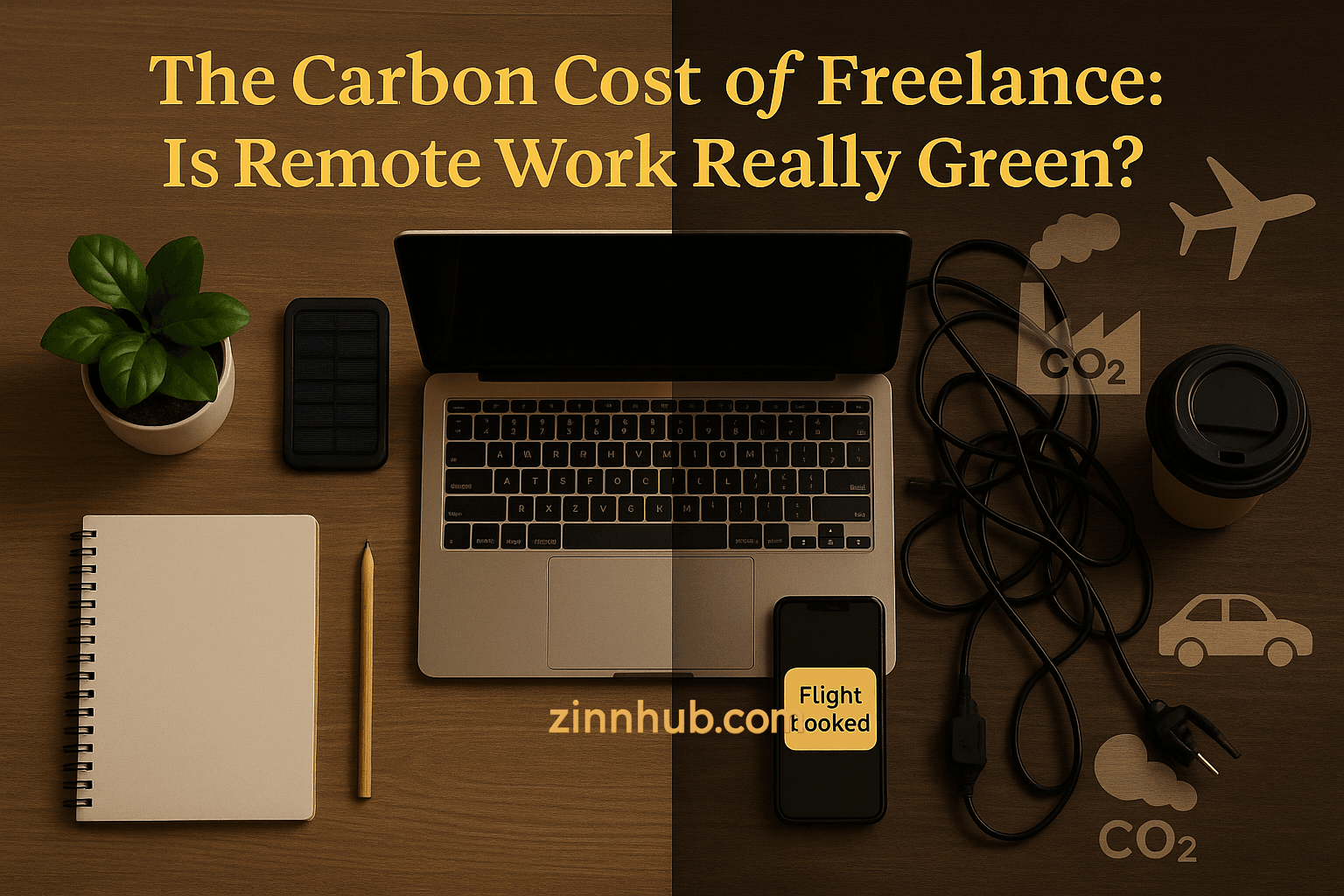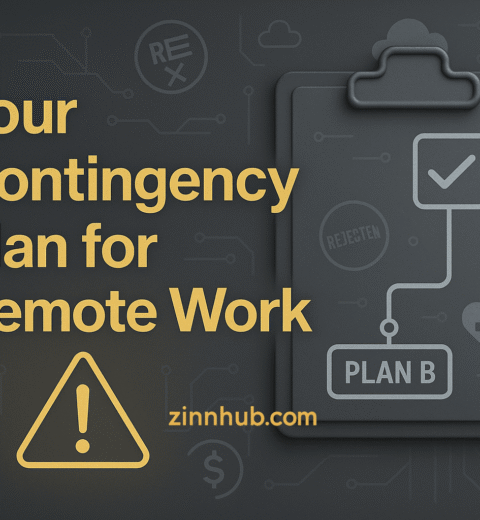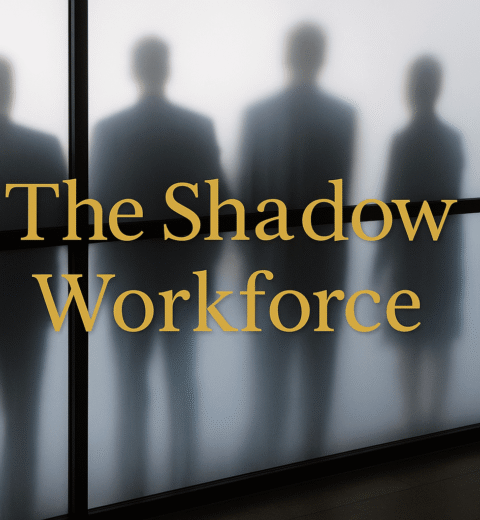Table of Contents
- Why Your Laptop Lifestyle Isn’t as Eco-Friendly as You Think
- The Hidden Carbon Costs: Where Your Impact Really Comes From
- Traditional vs. Digital: The Carbon Face-Off
- Mythbusting: When Is Remote Work Greener?
- Your Green Freelancing Toolkit: From Carbon Criminal to Eco-Warrior
- Practical Action Steps You Can Take Today
- Progress, Not Perfection
- Further Reading & Useful Tools
- Frequently Asked Questions
- 1. What is the carbon cost of freelance work?
- 2. Is remote work really green and eco-friendly?
- 3. How can freelancers reduce their carbon footprint?
- 4. What are some green freelancing tips for sustainable remote work?
- 5. How much CO₂ do video calls and digital tools produce during remote work?
- 6. Are digital nomads’ carbon emissions higher than traditional workers?
- 7. What is the environmental impact of freelancing compared to office jobs?
- 8. How can I make my freelance business carbon-neutral?
- 9. What are the best tools for green and sustainable freelance work?
- 10. Why should I care about the sustainability of my remote work practices?
- Frequently Asked Questions
- Your Green Freelance Future Starts Now
Picture this: You’ve just rolled out of bed, laptop in hand, ready to tackle another day of freelance work from your kitchen table. No commute, no office building guzzling electricity, no petrol fumes. “The Carbon Cost of Freelance: Is Remote Work Really Green?” is probably the last thing on your mind. You’re saving the planet, right?
Well… not so fast.
Why Your Laptop Lifestyle Isn’t as Eco-Friendly as You Think
For years, many of us have been patting ourselves on the back for ditching the daily commute, convinced that remote freelancing is automatically good for the planet. No gridlocked traffic. No plastic-wrapped meal deals. No air-con on full blast just because your manager likes to wear jumpers in July.
It’s a comforting image. But the reality of remote freelancing’s environmental impact is far more complex—and, frankly, a bit shocking. Today, we’re pulling back the curtain on the hidden carbon costs of our digital nomad dreams and, more importantly, how you can make your freelance career genuinely sustainable.
The Hidden Carbon Costs: Where Your Impact Really Comes From
The Cloud Isn’t Floating in the Sky
Every Zoom call, every file uploaded to Dropbox, every website you build—it all lives in massive data centres that now consume 240–460 terawatt-hours (TWh) of electricity annually (IEA, 2022), about 1–1.3% of global electricity demand. That’s more than the electricity consumption of many countries. And projections suggest this could triple by 2030 if trends continue.
Device Manufacturing Madness
Your shiny new MacBook? Producing one can generate around 400kg of CO₂ emissions, with the vast majority coming from manufacturing. The constant upgrade cycle many freelancers fall into means we’re contributing to the 62 million tonnes of e-waste produced globally each year (Global E-waste Monitor 2024). Not quite as “virtual” as we’d like to think.
Streaming, Video Calls, and the Always-On Culture
Video streaming and video conferencing are surprisingly energy-intensive. Estimates for CO₂ emissions per hour of video conferencing range from 150g to 1kg depending on devices, network, and electricity source (MIT study). Studies also show that remote workers can use 7–30% more electricity at home than they did in office settings, thanks to longer hours and more devices left running.
The Nomad Paradox: Travel Emissions
Here’s where it gets awkward for digital nomads. A London–Bali return flight produces roughly 7 tonnes of CO₂ per passenger (MyClimate.org). Even if you stay put for months, a couple of intercontinental trips a year can obliterate any environmental savings from skipping the commute.
Cryptocurrency Complications: Going Greener With Your Digital Wallet
Getting paid in cryptocurrency might be trendy, but it’s not great for the planet. One Bitcoin transaction can use as much energy as 100,000 to 900,000 Visa transactions (estimates vary; Cambridge Bitcoin Electricity Consumption Index). Ethereum (since its 2022 upgrade to Proof of Stake) and other Proof of Stake blockchains like Solana and Polygon are far greener options for crypto payments. If your clients want to pay in crypto, consider steering them toward these networks.
Traditional vs. Digital: The Carbon Face-Off
Let’s meet two Zinner freelancers:
Sarah, a traditional office consultant, and Marcus, a globe-trotting digital marketer.
Sarah’s Annual Carbon Footprint:
- Daily 20-mile commute: 2.3 tonnes CO₂
- Office energy share: 1.2 tonnes CO₂
- Work devices: 0.8 tonnes CO₂
- Total: 4.3 tonnes CO₂
Marcus’s Annual Carbon Footprint:
- Zero commute: 0 tonnes CO₂
- Home office energy: 0.9 tonnes CO₂
- Devices & cloud usage: 1.8 tonnes CO₂
- Two long-haul return flights: 14 tonnes CO₂
- Total: 16.7 tonnes CO₂
Plot twist, eh? Sometimes the grass isn’t greener—it’s just better lit by your ring light.
Mythbusting: When Is Remote Work Greener?
| Work Style | Carbon Impact |
|---|---|
| Freelancer, works from home | Generally lowest |
| Digital nomad, stays put 6+ months | Still good—watch flights |
| Nomad, hops every 2–4 weeks | High (flight-heavy) |
| Office commuter, long daily drives | Also high |
The greenest freelancing is done with your feet—and your files—planted firmly in one place, using minimal gear, minimal flights, and eco-friendly tech.
Your Green Freelancing Toolkit: From Carbon Criminal to Eco-Warrior
Right, enough doom and gloom. Here’s how to transform your freelance practice into something genuinely sustainable (and maybe even brag-worthy):
Green Gear Guide
Devices That Don’t Cost the Earth
- Fairphone: Ethically sourced, repairable smartphone
- Framework Laptop: Modular, repairable, upgradeable
- Refurbished equipment: Sites like Back Market offer high-quality, warrantied devices
Energy-Saving Software
- Ecosia: Search engine that plants trees as you work
- Local-first tools: Use Obsidian or Notion in offline mode to reduce cloud use
- JouleBug: Track your digital carbon footprint and habits
Carbon-Neutral Hosting
- Green Web Foundation: Directory of sustainable web hosts
- Providers like Kualo, GreenGeeks, and A2 Hosting run on renewable energy
The Freelancer Carbon Challenge: Your 30-Day Green Transformation
Ready to gamify your journey? Try this:
Week 1: Measure
- Install a carbon tracking app (Capture, Klima)
- Audit your devices and energy usage
- Calculate your baseline carbon footprint
Week 2: Reduce
- Switch to a green energy provider at home
- Try “No Video Fridays” for calls
- Set sleep mode on all your devices
- Walk, cycle, or use public transport for local meetings
Week 3: Offset
- Choose verified carbon offset programmes
- Plant trees via Ecologi or similar
- Move projects to carbon-neutral service providers
Week 4: Advocate
- Add a green pledge to your freelance profile
- Educate clients about sustainable practices
- Share your journey on social with #GreenFreelanceChallenge
Platform-Level Progress: What Forward-Thinking Companies Are Doing
At ZinnHub, we’re rolling up our (organic cotton) sleeves and implementing plans for the future:
- Carbon offset programmes for every transaction
- Green badges for eco-conscious freelancers
- Built-in carbon calculators for projects and proposals
- Tree-planting partnerships for a living legacy
- Local freelancer matching to cut travel emissions
Stay tuned for the “Green Zinner” leaderboard and more ways to showcase your climate-positive work.
Practical Action Steps You Can Take Today
- Right-size your cloud storage: Delete duplicates and archive old projects—every gigabyte uses energy.
- Batch your online activities: Group video calls and uploads to avoid always-on devices.
- Choose clients wisely: Prioritise local or sustainability-minded clients when you can.
- Optimise your workspace: Use LED bulbs, smart power strips, and good insulation—cut home office energy by up to 40%.
- Embrace async communication: Swap some video calls for written updates—it’s up to 50x more energy-efficient.
Progress, Not Perfection
Let’s be real: Freelancing can be greener than traditional office work, but it’s not automatic. The beauty of freelance life is that you can choose your impact—no need to wait for the boss’s permission.
Small actions, compounded across the estimated 1.57 billion freelancers globally (Genius, 2024), make a colossal difference.
The narrative that “remote work is always green” needs an update. Yes, we’ve ditched the commute, but we’ve also created new climate challenges. The good news? As freelancers, we’re agile enough to lead the charge towards truly sustainable work.
Further Reading & Useful Tools
- Carbon Footprint Calculator
- Green Web Foundation: Green Hosting Directory
- BBC Future: The Carbon Footprint of the Internet
- Ecologi: Verified Carbon Offsets
- Back Market: Refurbished Devices
Frequently Asked Questions
1. What is the carbon cost of freelance work?
The carbon cost of freelance work refers to the total CO₂ emissions produced by freelancers during their remote work activities. This includes the energy consumed by data centres, electronic devices, video calls, cloud storage, and even travel related to digital nomad lifestyles.
2. Is remote work really green and eco-friendly?
While remote work eliminates daily commutes and office energy use, it isn’t automatically green. Remote work can still have a significant carbon footprint due to increased home energy consumption, the use of digital tools, and the environmental impact of frequent travel by digital nomads.
3. How can freelancers reduce their carbon footprint?
Freelancers can reduce their carbon footprint by using energy-efficient devices, choosing green web hosting, minimising video calls, reducing unnecessary file storage, and travelling less frequently. Adopting sustainable freelance practices helps make remote work more eco-friendly.
4. What are some green freelancing tips for sustainable remote work?
Green freelancing tips include: buying refurbished equipment, using carbon-neutral web hosts, switching to renewable energy at home, prioritising async communication over video meetings, and offsetting travel emissions through verified carbon offset programmes.
5. How much CO₂ do video calls and digital tools produce during remote work?
Video calls and digital tools contribute to the carbon footprint of freelancing. Estimates show that one hour of video conferencing can emit between 150g and 1kg of CO₂, depending on the technology and energy source. Regular use of digital platforms increases this impact.
6. Are digital nomads’ carbon emissions higher than traditional workers?
Digital nomads can have a higher carbon footprint than traditional workers, especially if they fly frequently between countries. International travel can generate more CO₂ emissions than commuting, making it important for digital nomads to adopt sustainable travel habits.
7. What is the environmental impact of freelancing compared to office jobs?
Freelancing can be more sustainable than office work if approached thoughtfully. While remote workers avoid commuting and office energy use, their environmental impact depends on their home energy efficiency, travel habits, and use of digital technologies.
8. How can I make my freelance business carbon-neutral?
To make your freelance business carbon-neutral, calculate your carbon footprint, reduce unnecessary energy use, choose green service providers, use eco-friendly hardware, and invest in reputable carbon offset projects.
9. What are the best tools for green and sustainable freelance work?
The best tools for green and sustainable freelance work include energy-saving laptops, platforms like Ecosia, carbon-neutral web hosting (e.g., GreenGeeks, Kualo), and carbon tracking apps such as Capture or Klima.
10. Why should I care about the sustainability of my remote work practices?
Caring about sustainability in remote work benefits both the planet and your professional reputation. Clients increasingly value eco-friendly freelancers, and adopting sustainable practices can set you apart while helping reduce your freelance carbon footprint.
Your Green Freelance Future Starts Now
The planet doesn’t need perfect eco-warriors. It needs millions of imperfect freelancers making better choices—one device, one project, one low-carbon client at a time.
Calculate your carbon footprint right now using the Carbon Footprint Calculator. Then pick one step from this guide and put it into action today.
So, what’s your first move going to be? Share your tips, stories, or even your struggles below—Let’s show the world how remote work can really lead the way.



